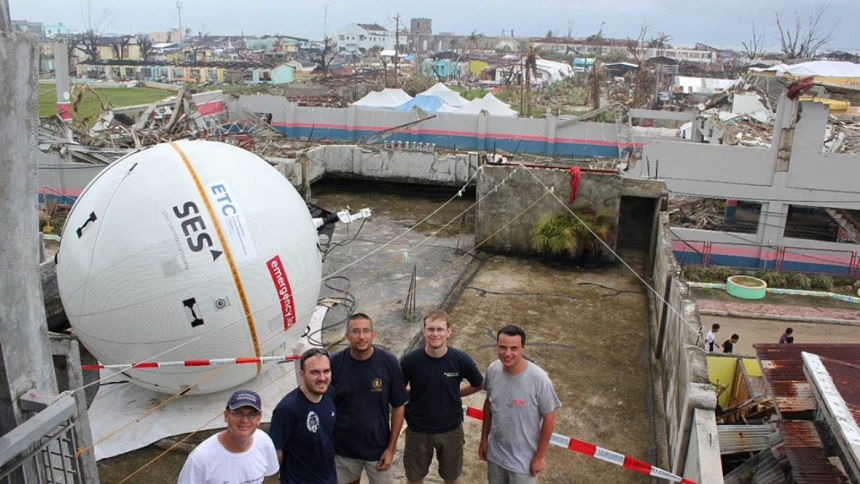Communication in seven boxes

No assistance without coordination. No coordination without communication. However, the latter usually collapses in natural disasters. This is where emergency.lu comes in. Developed by Luxembourg companies, this autonomously operated mobile telecommunications platform is able to restore communication networks in a disaster area within half a day.
Not too long ago, Vanuatu was named the happiest place on earth by a foundation promoting social well-being and environmental sustainability. Since March 15, 2015, however, nothing is the same on the islands. On that day Cyclone Pam hit the nation in the south Pacific with speeds of up to 300 km/h. Dozens of people died and within seconds three quarters of the 250,000 inhabitants became homeless. The government declared a state of emergency and asked for international aid.
Luxembourg responded immediately. On board: emergency. lu's "Rapid Deployment Kit". On the team: Brice Tavernier, ICT expert and volunteer with the humanitarian intervention team of Luxembourg's emergency services. "Our mission was to provide the United Nations with technical communications support on site. Specifically, this meant building a functioning network to enable the coordination of search teams and survey flights, and to define assistance to meet the real needs of the population on the separate, variously affected islands." The mobile satellite units of emergency.lu – allowing the immediate set-up of broadband internet and mobile phone networks – are tailored to this purpose.
Haiti and the Luxembourg government
After the severe earthquake in 2010 in Haiti, the Luxembourg government struck an agreement with local companies SES and Hitec Luxembourg for the development and global deployment of a solution for use in natural disaster situations and/or humanitarian missions. The airline "Luxembourg Air Ambulance" became an additional partner, ensuring the transport of the "Rapid Deployment Kits" when needed. The "baby" of this partnership first saw the light of day in April 2011 and was named emergency.lu
From 72 to 12 hours – thanks to SES and Hitec
"In disaster areas with collapsed communications networks, makeshift restoration usually takes at least 72 hours.. Thanks to emergency.lu we are able to restore communications within 12 hours, including travel," explained Alan Kuresevic, Vice-President, Engineering" at SES TechCom Services.
"Learning from the Haiti experience, Luxembourg took the initiative in the shape of a public-private partnership with SES and Hitec and developed the mobile satellite stations. They are so far unique. Luxembourg is the only country worldwide to be able to provide such a solution," Alan Kuresevic continued.
This has been made possible by the compact size of the "Rapid Deployment Kits". They weigh only 130 kilogrammes and are transported in seven cases, adhering to standard airline specifications. The system works autonomously and does not require an external power source thanks to a diesel generator.
"One of the mobile satellite stations is kept at the airport in Findel and is immediately available in case of emergency. This means that we can take off within two hours," the SES engineer said. Another station is kept at Dubai airport, speeding up transportation to all corners of the world. "Once at its destination, the cushion of the satellite antenna is inflated in 30-40 minutes and it is ready," Alan Kuresevic added. On longer deployments, the antenna with an inflatable base is replaced by a fixed version.
Success is proving the inventors right: in the meantime emergency.lu counts 17 "Rapid Deployment Kits", including six with inflatable antenna. The aim is to have 40 mobile stations.
70 volunteers can use the "Rapid Deployment Kits"
Around 70 volunteers from within the country and abroad have been trained to use the "Rapid Deployment Kits" since the launch of emergency.lu. This enables Luxembourg volunteers to hand over the telecommunications platform to foreign colleagues in the affected area without the relief mission being compromised. "The platform usually remains on site until the local communications network is operational again. We are not a competitor with local operators; emergency.lu is not commercially oriented. When we are asked to remain longer, we clearly indicate that the continued use of our services will be charged," Alan Kuresevic further explained.
The United Nations have used the services of emergency.lu on several occasions. For instance, after the devastating typhoon Haiyan in the Philippines in November 2013, emergency.lu provided the foundation for an efficient coordination of assistance. "That was my first mission in a disaster area," Brice Tavernier recalled, still moved by the events. "This mission deeply affected me, the all-encompassing destruction and the countless bodies lying around everywhere.I had never seen anything like it."
The mobile telecommunications platform emergency.lu represents a successful cooperation between man and machine, which promises assistance to people in need in nearly every corner of the planet within a short amount of time. SES and Hitec deliver the technology, the government provides the funding, Brice Tavernier and his colleagues from Luxembourg and around the world organise the communications on site. Emergency.lu is currently working in the earthquake-hit Nepal.
For further information, visit their website: http://www.emergency.lu/

 For all latest news, follow The Daily Star's Google News channel.
For all latest news, follow The Daily Star's Google News channel. 



Comments